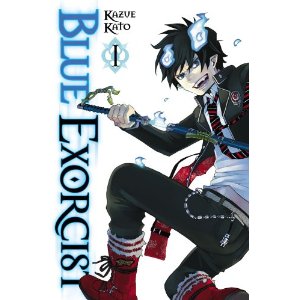I feel a little bit divided about Itsuwaribito. In theory I really like the idea of a shonen manga hero who gets by with cleverness instead of devoting himself to fighting and mystical power-ups. In practice, the stories that rely on Utsuho’s lying sometimes seem a bit artificial. Still, this ends up being one of the more entertaining new shonen series from Viz.
Itsuwaribito Volume 2 by Yuuki Iinuma
The second volume of this series shows Utsuho doing what most shonen heroes do after the first volume – start putting together a team. He parts ways with the acerbic medicine man Yakuma, each of them vowing never to cross paths again, only for them to run across each other one panel later. A demonic man who hates liars is stacking up bodies in a nearby forest. Yakuma thinks he hears a cry for help, but Utsuho is determined not to get involved. Venturing into the forest forces a confrontation with the mass murderer. The character design of the bad guy was genuinely creepy, as he has a rough triangle for a mouth and a grid of teeth. Utsuho is forced into a confrontation when Yakuma is cornered. They then turn to a different type of quest, visiting an island that is a place of exile for liars like Utsuho.
When they arrive on the island, it is clear that it is full of traps and trickery. They get attacked before they even reach the shore. Yakuma’s medicine chest gets stolen and they meet a faction of people on the island lead by a young girl named Neya, who promises to fetch the missing chest and comes right back. As the minutes tick by Yakuma dares to speculate that Utsuho might have gotten tricked by a girl, provoking frantic denials at the thought that the master liar was lied to.
Itsuwaribito Volume 3 Yuuki Iinuma
The third volume focuses on different types of families. Accomplished female liar Neya is actually the main caretaker for a small village of people trapped in exile on the island, defending themselves from rival gangs. If she has the opportunity to leave will she build a new life for herself and pave the way for the people she cares for, or will her sense of obligation compel her to stay in exile? The main menace in this volume comes from a man with a bandaged face who seems to be particularly interested in Utsuho’s animal sidekick Pochi and determined to bring misery to all the humans he sees. For all of Utsuho’s crafty lying and cool exterior, when one of his companions is in trouble he doesn’t hesitate to defend them.
Although I confess I had a few moments of internal eye-rolling when Utsuho ended up on an island of liars, in general I’m finding Itsuwaribito entertaining. It blends humor with the occasional poignant moment about the value of friendship, and while the general structure of the plot with Utsuho picking up a motley crew of companions on his journeys is pretty typical of shonen manga I’m still enjoying the series so far. I’m looking forward to see what happens with Neya, as she provides Utsuho with a counterpart that is equally adept at lying to react to.
Review copies provided by the publisher.


